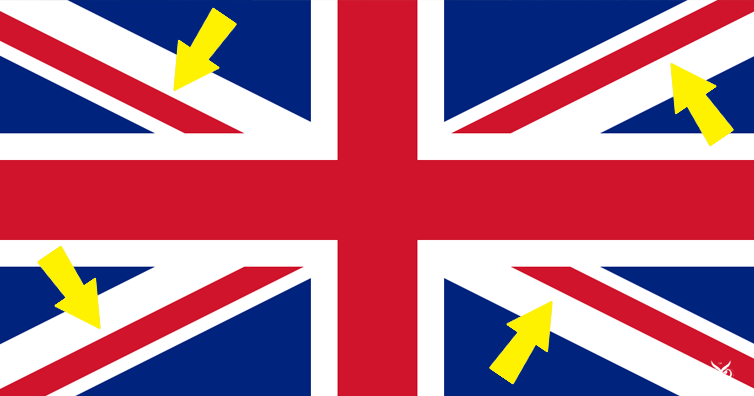First of all, if you suffer from OCD, sorry but it’s now too late. Once you’ve seen that the X lines of the British flag are not centered, there’s now way back. You will be bothered for the rest of your life whenever you see it.
But why was it designed that way? Is there a reason for it or is it just a design error? Well, of course there is a reason and this is what we are going to see today.
The British flag (also called Union Jack flag) is made up of three crosses: (the article continues after the ad)
– the cross of St George, representing England, a red cross on a white (representing silver) background;
– the cross of St Patrick, representing Ireland, a red saltire on a white background;
– and the cross of St Andrew, representing Scotland, a white saltire on a blue background.
The white in all of these flags is known in heraldry as “argent”, meaning “silver”, and is one of the two “metals”, the other being “or” (“gold”) which is represented as yellow; the red and blue (or “gules” and “azure”) are “colours”. One of the rules in heraldry is that you can’t put a metal on another metal, or a colour on another colour. This already causes a problem if you try to put the cross of St George on the blue background of the cross of St Andrew, because then you’d get gules (a colour) on azure (another colour), which isn’t allowed. To avoid that, the red cross is “fimbriated argent”, meaning it’s given a white outline.
The original Union Flag was created when England and Scotland were united as Great Britain, and so only had the crosses of St George and St Andrew: it looked like this:
Later, Ireland entered into a union with Great Britain, and it was represented by the cross of St Patrick. But if you put the cross of St Patrick and the cross of St Andrew on top of each other, all you see is whichever cross is on top — you don’t see the one below.
So to depict both crosses, they were quartered and counterchanged: they were split so that each “arm” of the “X” showed half argent (St Andrew) and half gules (St Patrick). And then the quartered saltire was fimbriated argent to avoid the “colour on colour” problem.
This is what you see if you take away the cross of St George.
The “red lines” aren’t continuous, but they meet at a point. The narrow white strips are the fimbriation; the wider white strips are what is visible of the cross of St Andrew.
If you like what you read, then you will definitely love this one: The Flag Of Philippines Changes Every Time The Country Is In War
Source: rewboss / Reddit
Photo: I’m A Useless Info Junkie
Widget not in any sidebars

